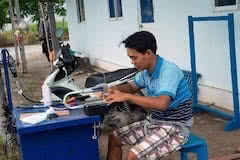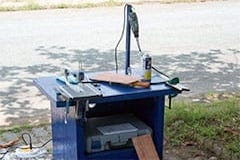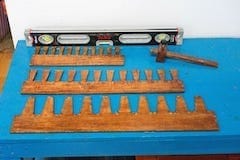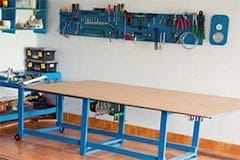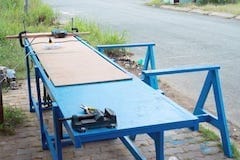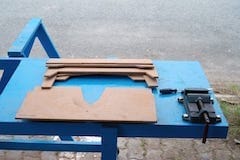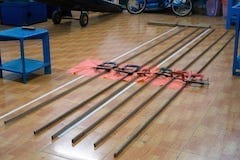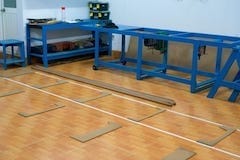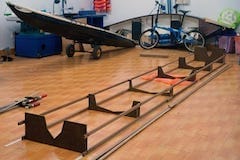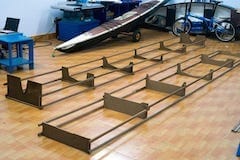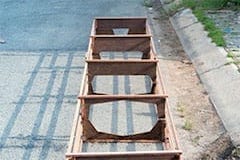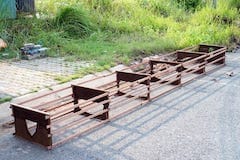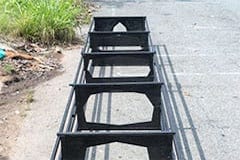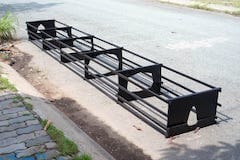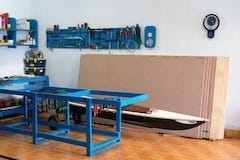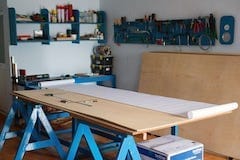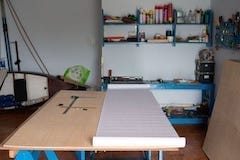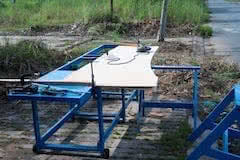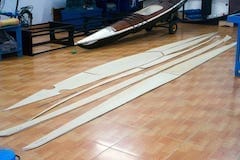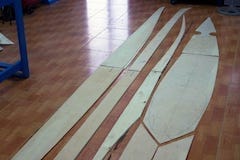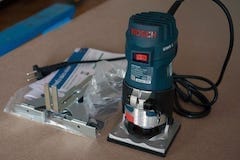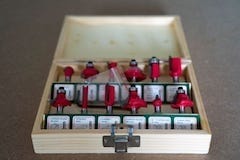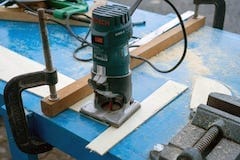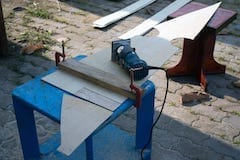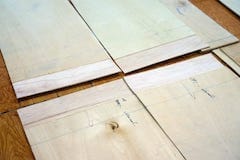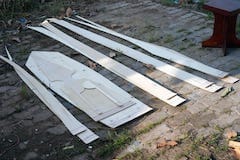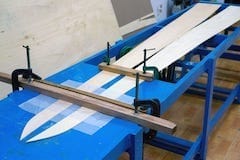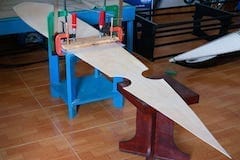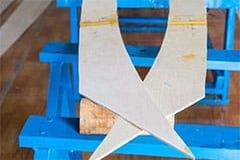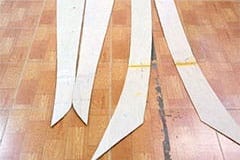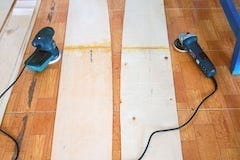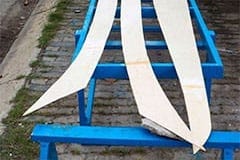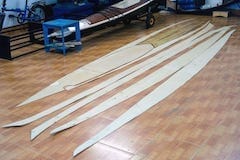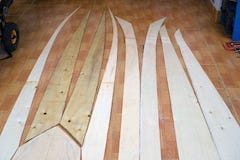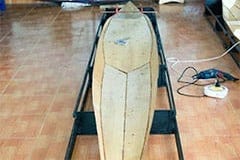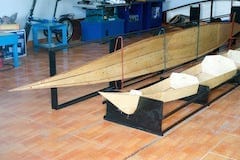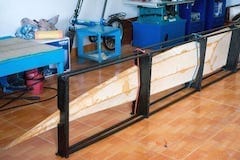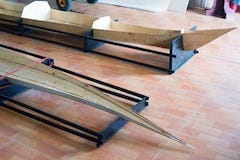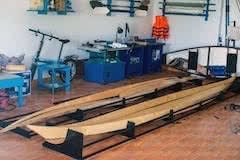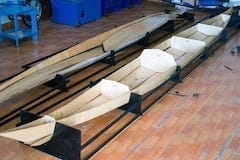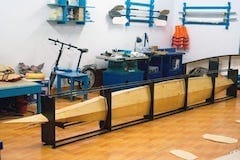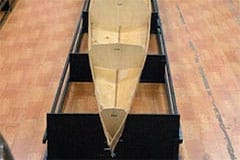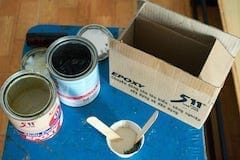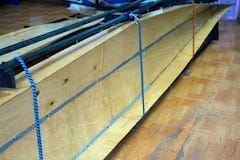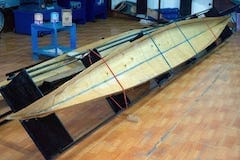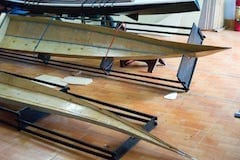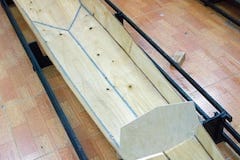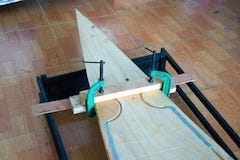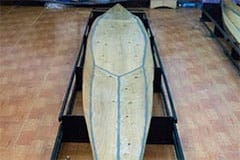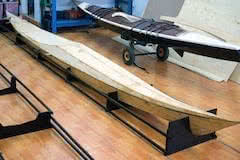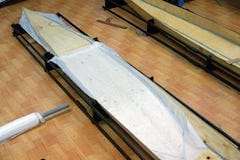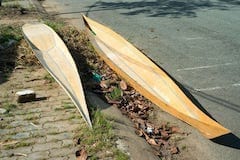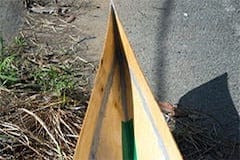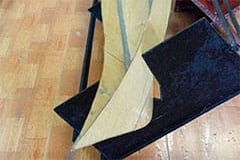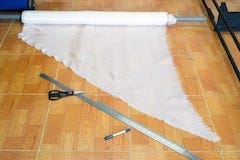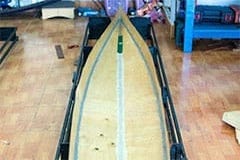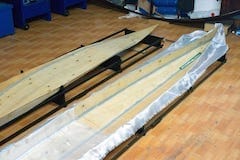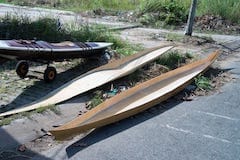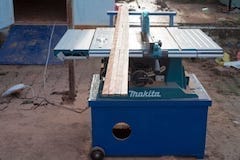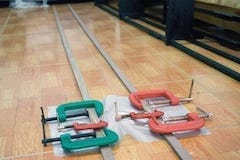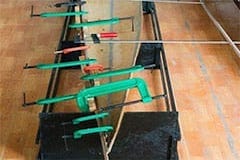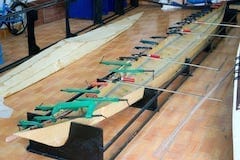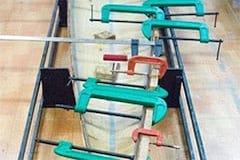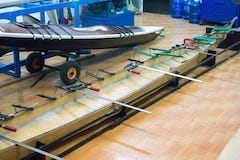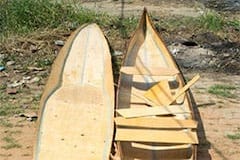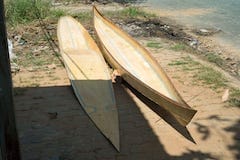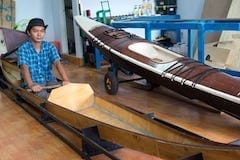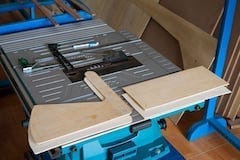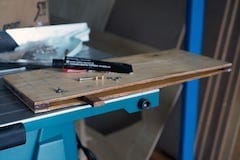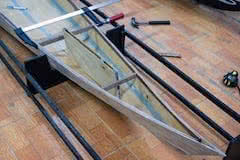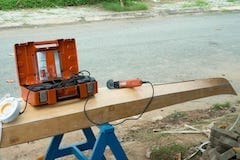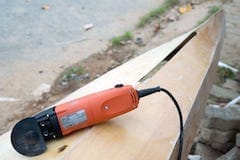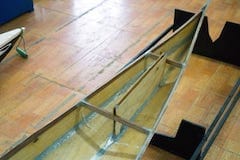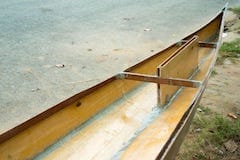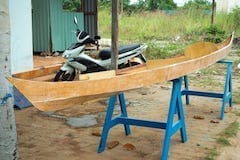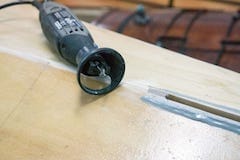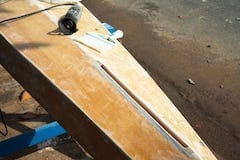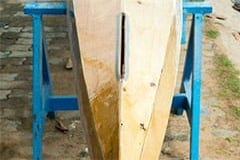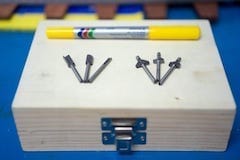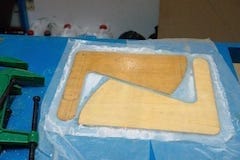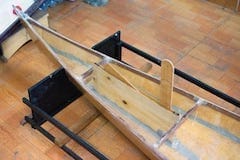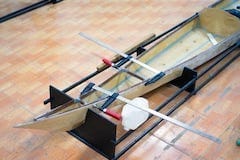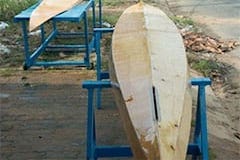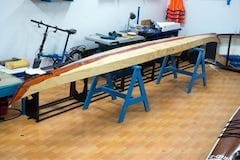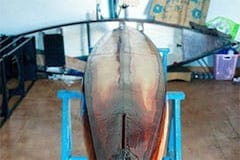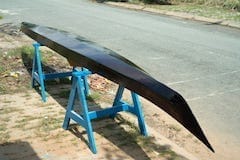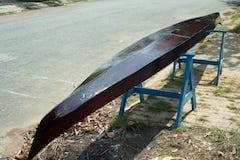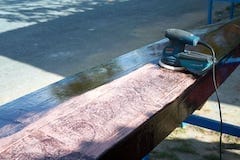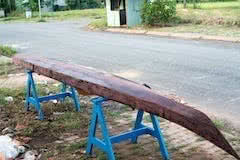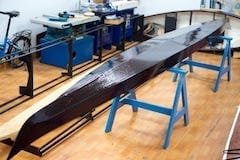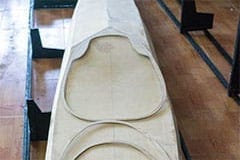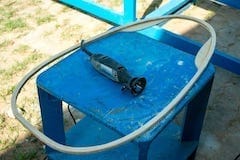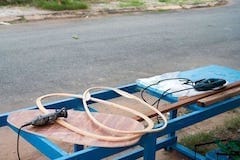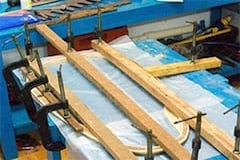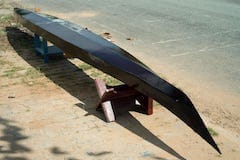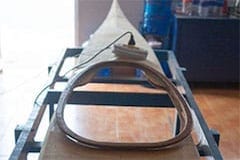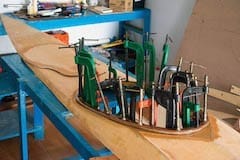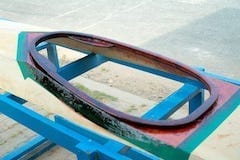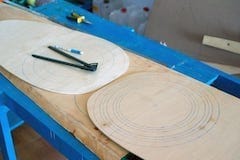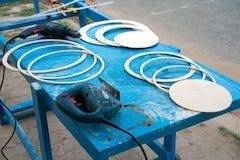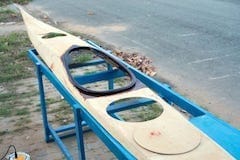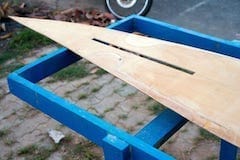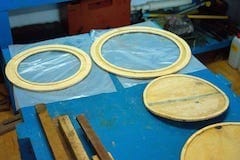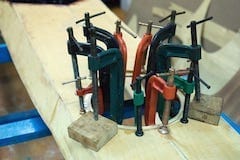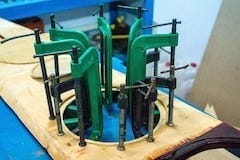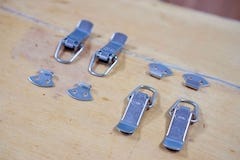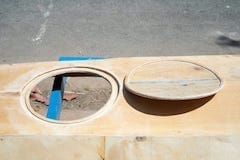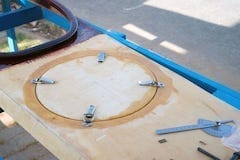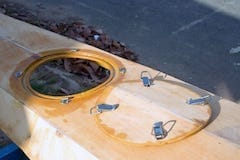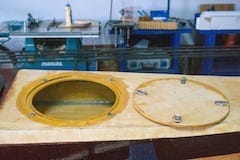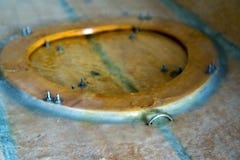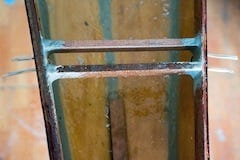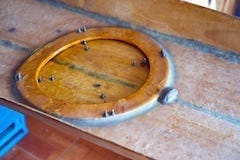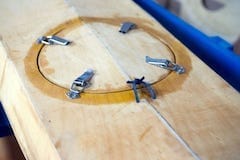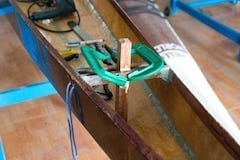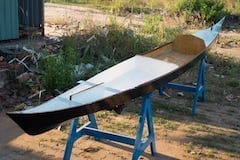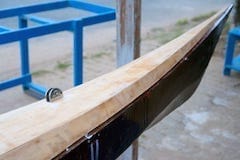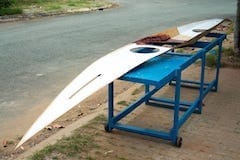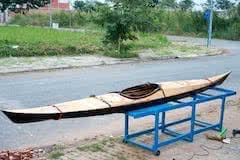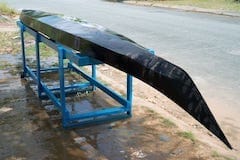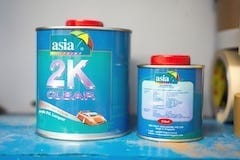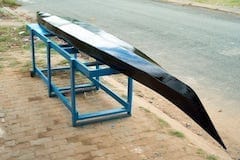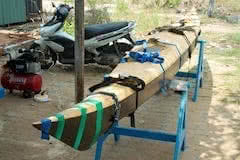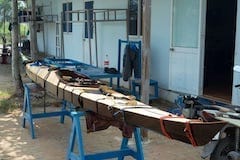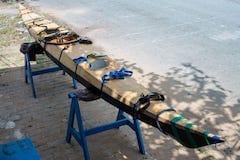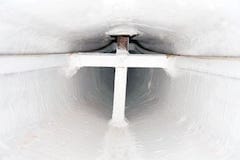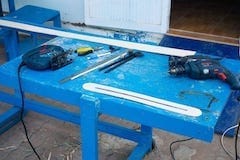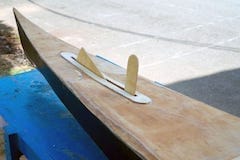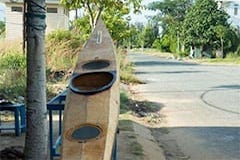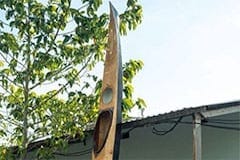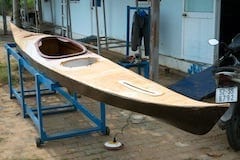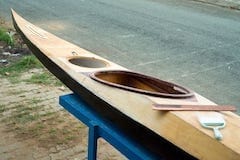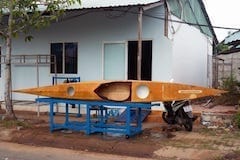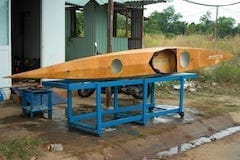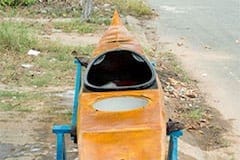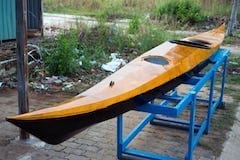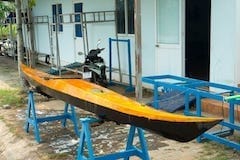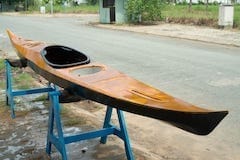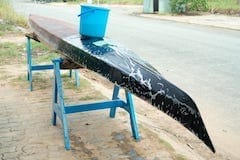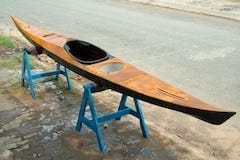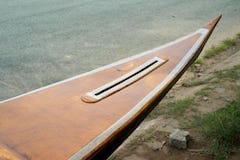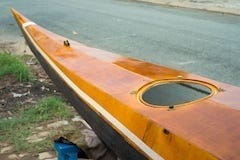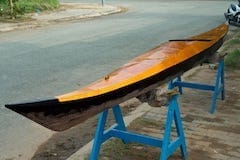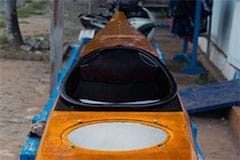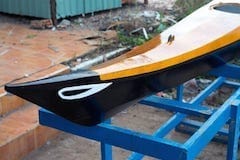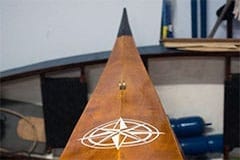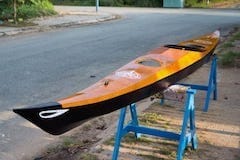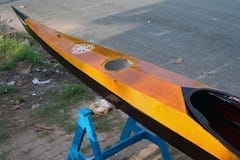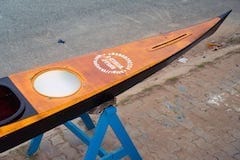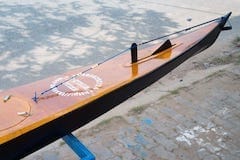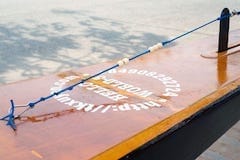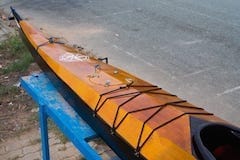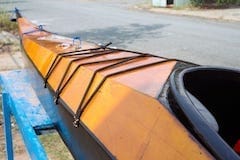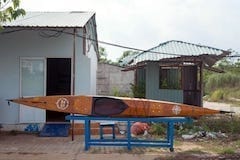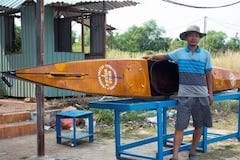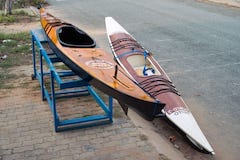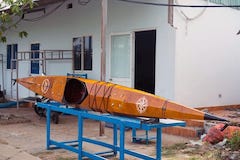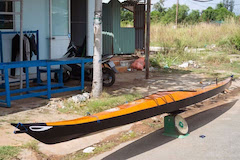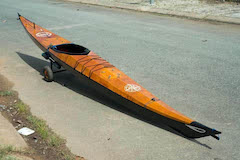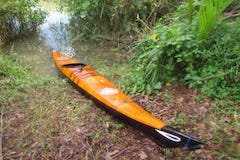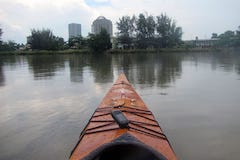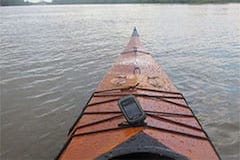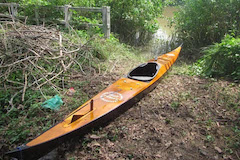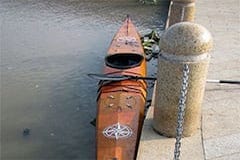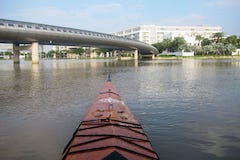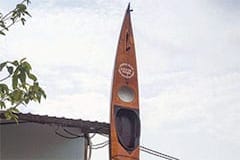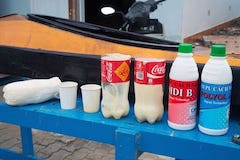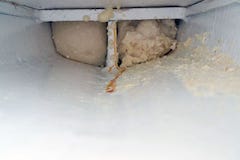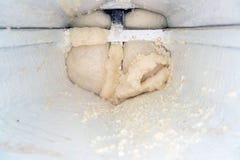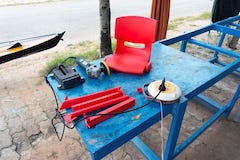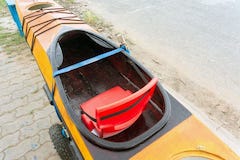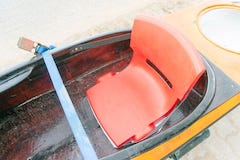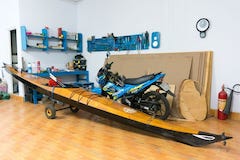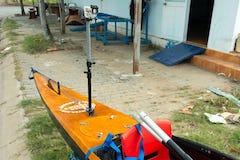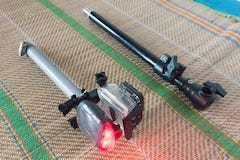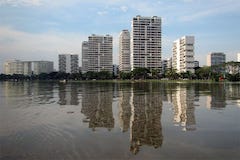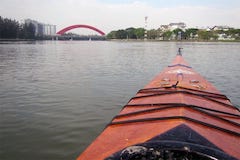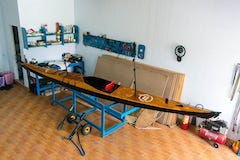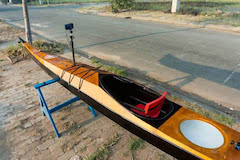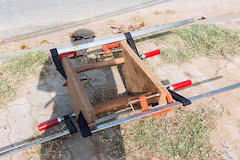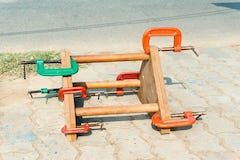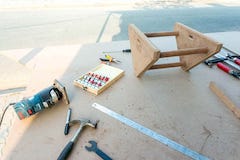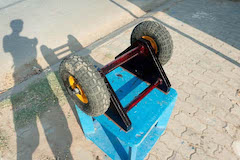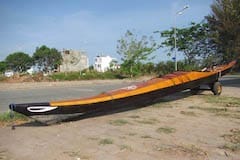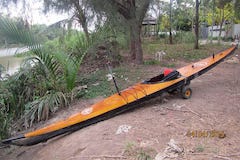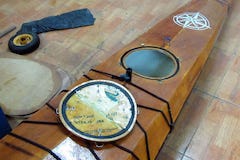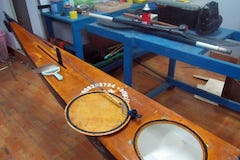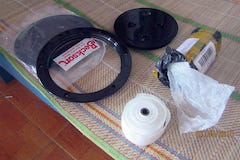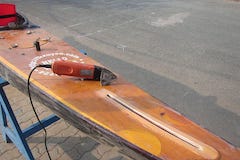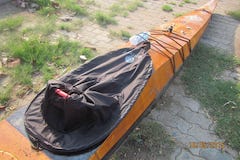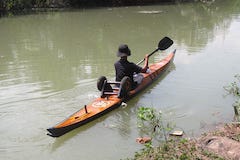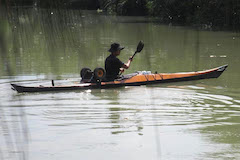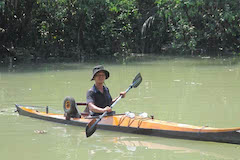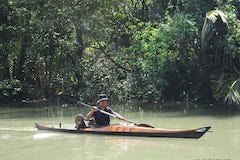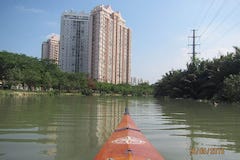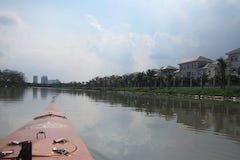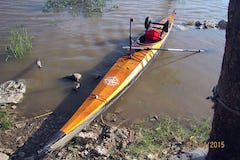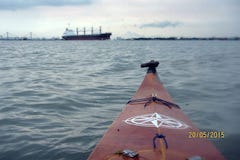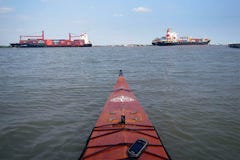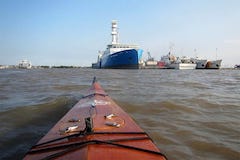All preparations is almost finished, to “lay the keel” and start the building of Hello World – 3, my next boat, a Nick Schade designed, 18 feet (5.55 m) S&G Night Heron sea kayak. Many would ask why building another boat, while I’ve already had the Hello World – 1 & 2. Actually, HW – 1 is just a simple, slow canoe for poking around, HW – 2 is a recreational kayak suitable only for short trips, as proved in my last paddling to Vũng Tàu in June this year.
First, consider some facts, many of Vietnam islands are around 100 km off from shore. Phú Quý island is about 85 km from Mũi Né, Phan Thiết; Phú Quốc island is 110 km from Rạch Giá, Hà Tiên; Thổ Chu island is another 100 km from the southern most point of Phú Quốc; Côn Đảo island is about 95 km from Hậu Giang estuary, Sóc Trăng; Bạch Long Vỹ island is also 100 km from Cát Bà, Hải Phòng… Some are nearer such as: Cồn Cỏ, Chàm, Lý Sơn islands… all around 30 km.
Second, consider some other facts. If your sustained paddling speed is around 5 ~ 6 kmph, it’s not really possible to reach those islands, at least with a coastal – cruising small kayak which is, by design, not suited for multi – days sea crossing without resting, 14 ~ 16 hours of continuous paddling is almost the upper limit for an average man like me, after which you would need a good sleep to recover. Obviously a boat capable of sustaining 8 ~ 9 kmph and beyond is very much needed.
Third, is the target of 100 ~ 110 km in 24 hours really feasible!? The answer is: ça dépend!
It depends on too many things: the weather, the wind, waves, the current, the temperature, all of the unknown factors. And for the known factors: your boat, your equipments, your physical preparation, your planning and strategy… all need to be the – very – best – of – class to push the limits and reach the target. That’s why I would invest lots of time and efforts into the building of this HW – 3 kayak.
I am making a slow start, working mainly on the implementation plan. It’s better to think out all building details beforehand carefully and thoroughly. Unlike a software project though, which is more flexible, in a hardware project, you would have little chance to correct something that went wrong, or correcting it would cost much time, effort, materials… There’re many things to be considered, and require experiences to get done right! One important concern is weight.
HW – 1 weighs at 35 kg, HW – 2 is roughly 30 kg. With my previous two boats, and with my inexperiences, I did put lots more materials into the building, hoping for strength, but they turned out to be really heavy indeed. If HW – 3 could be built at 20 kg, it’s a great success! Imagine that your boat is 10 kg lighter, and that 10 kg saved could be used for additional food, drink on longer trips! And of course, the weight saving should come without any compromisation on quality and durability!
HW – 3 is a really complicated boat, the hull will be stitched together with 4 plywood bilges , while the deck has 5 main bilges. And since the 5.5 m hull length exceeds twice the standard plywood sheet length (2.44 m), there will be 2 joints in each of the hull’s bilges, which I’ve decided to be dovetail joints to further reduce weight and increase strength. In all, every parts of this boat will be more complicated (compared to my previous boats), and hence requires ‘astute’ planning and execution.
Below, I’m building the two halves (hull and deck) of the framing box that would help forming the kayak from plywood planks into the precise desired shape! With the new air compressor and nail gun and glue, all these frames are just quick and easy task which takes just several hours to complete. I’ve switched to using the excellent TiteBond 2 wood glue instead of other normal Polyvinyl Acetate (PVA), which has much better water resistance capability.
Having put no pressure on a launch day, I spend my free time thinking over about the implementation details, trying to apply lessons learnt from my previous boats. From what I’ve learnt from the internet, boat building forums, books… to the reality is a quite different thing. Here in Vietnam, the materials, tools are not the same, no West System epoxy, no marine grade plywood, no good carbon fiber, even the vendors don’t know what is S – class fiberglass.
“The epoxy can be mixed at any ratio”, said the seller, no reliable way to mix paints to the correct desired colors, etc… even the “words”, the “terminologies” used to communicate between the seller and buyer is kind of mess, no standard, no common understanding. Well, a bit off topic here but, Vietnam has always been a very bizarrely unorthodox country, anyone has the same thinking as me!? At least I’ve been feeling so ever since I was 17, 18 years old or even younger.
Hence, my boat building progress has been a tedious learning curve, as I have no trustable standards here, and many trials and fails have to be done. Anyhow, after 2 builds, I’m quite confident now, to start the third boat that I think will meet my quality standards. Begin to measure, draw, and cut of the plywood today, then joining the parts together, then stitch them up. Stitch and Glue is no longer a challenger for my skills now, maybe with the next boat, I’ll try another different building method.
But that’s another thing, just concentrate on the building of Hello World – 3 for now, simple things that need to be properly executed! In total, 22 pieces cut, and 15 joints need to be made just for the hull and deck. The overall structure of this kayak is like nutshell, you will be building 2 halves, then stitch them together. Cutting only takes me half a day, but joining will take considerably much more time. I used 4 mm plywood for both the hull and deck, as I had difficulty purchasing the 3 mm ones.
Initially, I’d planned to use dovetail joint (or finger joint) to combine the plywood pieces together, but after cutting them, the 4 mm ply is quite thin and fragile to work on, so decided to use scarf joint instead. I used this Bosch laminate trimmer to remove 2 mm of ply on the surfaces, apply the TiteBond 2 glue, then clamp them together overnight. The Bosch fixed base router is an excellent tool, easy to adjust the router bit’s depth, small enough to be handled comfortably.
I’ve finished the scarf joints with almost no mistake. Next I would slightly sand the joints, then apply a layer of thinned epoxy (epoxy mixed with xylene solvent, this is what they call: penetrating epoxy), wait for a day for it to completely cure, then another layer of fiberglass with un – thinned epoxy. That would make the scarf joints strong enough. Some notes about epoxy below, and I hope the information would be useful for anyone having to work with epoxy in Vietnam.
There’re several kinds of epoxy resin, the ‘component A’, but for most tasks, the vendors will sell you the correct, most – frequently – used one, just say ‘epoxy resin’ and they will understand. For the ‘component B’, or the hardener, there’re at least 3 types that I know, named (after the local nomenclature): TETA, B5 and T31 (guess they’re the abbreviations of some chemical formulas). The TETA can be called the fast hardener, would cure within a few dozen minutes (in tropical weather).
TETA can be mixed by any ratio from 1/1 to 1/10 by weight (I usually mix in the 1/2 ~ 1/5 range), it produces a very hard but brittle output. The B5 can be called the slow hardener, it takes hours to cure, and need to be mixed at the exact 1/2 ratio. B5 produces a hard, but flexible result, with very little bubbles (but it’s more expensive compared to the TETA). Both has a light ammonia odor, B5 has to be stored in the dark to remains it chemical behaviors. For the T31, I haven’t tried to say anything about it.
The S&G Night Heron plan calls for beveling the bilges’ edges, and I follow it exactly, the bevels will help forming the boat shape more precisely, and also help to strengthen the putty joints. At first, I intended to use my routers to do the edges’ beveling, but switch to the frequently – used angle grinder instead. With the angle grinder, it’s harder to do the job, but it allows you to adjust the angle along the bilges, it’s steeper toward the boat’s aft and bow.
Next, I would add several layers of ‘penetrating epoxy’ onto the joined planks. This is my own experience in dealing with plywood, epoxy, and glassing. ‘Penetrating epoxy’ is nothing more than epoxy (with slow hardener, the B5) thinned with a solvent, I use xylene, which works best for me, mixed in 4/6 (epoxy/solvent) ratio. The plywood I could find here in Saigon is usually not of very high quality, I can see it absorb lots of thinned epoxy cause the veneer is so porous.
Using a slow hardener plus a solvent (applied in 3, 4 layers) causes the epoxy to cure slowly, usually within 12 ~ 18 hours. This prolonged time allows the plywood to absorb a significant amount of epoxy, and hence strenghthen the veneer. I estimate that the ‘penetrating epoxy’ adds up about 1 ~ 1.2 kg to the boat’s final weight, but that also helps glassing in the next steps to be more clean and strong, no more ‘white spots, white areas’ in fiberglass cause the wood is already well – saturated.
‘As usual’, I have the unpleasant feeling working with these long, narrow stripes of plywood. At this stage, they are very fragile and delicate, easy to break at any moment. But all would gradually build up strength once stitched together into a structure, have the seams filled with putty, and especially after being reinforced with fiberglass and epoxy. Nevertheless, it’s a very good feeling at this step to see the boat takes its initial shape, I work first on the hull, then proceed to the deck part.
The game of paper cutting and glueing again! 😀 The efforts of building all those framing box and temporary spacing bulkheads now come into fruition, seeing the bilges fit perfectly, not any noticeable gaps between them. All temporary bulkheads fits well to the hull and gives you an assured feeling that the boat is taking a good shape. It’s a real pleasure to see things properly executed and the building quality is under your control.
I use smaller wires and drill smaller holes into the bilges’ edges, as the 4 mm ply need less fastening force compared to the 5 mm one. The ugly thing about the “Stitch and Glue” method is that there’re so many small holes to be drilled into the hull, about 250 for this Hello World – 3, and later, you would need to check and re – fill each of the holes before glassing, a tedious task indeed. The bevelled edges leave a good space for putty to go into, making very clean seam lines.
Contrary to my initial thought, the sharp edges stand together pretty well, they need some adjustments, some dots of Cyano Acrylate glue here and there, and some little wires fastening too. But overall, both the deck and hull part shapes are very satisfactory to me. My boat building workshop has been becoming too overcrowded and cramped with three boats, and many kinds of machineries, to get some good shots showing off the boat shapes. Oh, those gorgeous curves and shapes!
I proceed slowly as I would have little free time this week: check the geometries, fasten the wires, then glue the seams. I use a good local epoxy putty called: 511. The 511 came into my favor since it has long curing time, don’t have to worry about epoxy burning in pot anymore (it’s a real problem in hot tropical climate). It also has a constant viscosity giving you a consistent, predictable working behaviors (unlike the fillet I manually mixed with wood flour, which differ from time to time).
The 511 putty comes in 2 parts: the resin and hardener, both premixed with a certain kind of thickening agent (filler), one has a dark gray and one has a yellowish color. Just stir them until you have a consistent light gray, highly viscous mixture. Since the hull and deck are tied to the framing boxes, I can easily slant the boxes to get the putty cured into the exact position, resulting into very clean seam lines. No need to use duct tapes to mask the lines though.
Fill the seams, wait for the putty to cure, cut the wires, then fill the remaining, repeat that for both the hull and deck parts. My precautious nature steps in as always, I made the seam lines of the hull much bolder and thicker, while the deck has very thin lines only. It’s easy, but it would take a few days to finish all these glueing tasks. After this, I would dry fit the two halves, to see if they match each other well, and to produce an initial impression of the final product also!
I recall glueing the seams of Hello World – 1, my first build. I used a small masonry trowel to apply the putty, about 1/2″ thick, and epoxy is all messing around. Now it’s much tidier and cleaner, and I don’t even need a pair of gloves and just work with my bare hands. Well, lots of little know – hows, skills and experiences that you could never learn if you don’t just really do it. About this time last year, I was so doubtful if I could even finish myself a boat, now it’s (almost) the third! 😀
A bit off topic here, but the thinking has been in my mind for a long time. About educational methodology, they’ve been arguing all the time, about knowledges, information, attitudes, practices, etc… But for me, it works a different way: if you want someone to build a boat, show him / her the immense beauty of the sea. Similarly, you don’t have to learn all those maths and algorithms to become a good coder, seek the inspiration in something rse, e.g: the art of hand writing calligraphy! 😀
Noticed that the hull’s plywood scarf joints happen to be closed to the seat and (sail) mast base position, I decided to reinforce those places with a narrow (20 cm) stripe of glass. Also noticed that a small paint roller helps distributing the epoxy more even and quicker compared to a brush, though it does absorb (and hence waste) a considerable amount of epoxy. Saigon this season is so hot, all glassing need to be done at night, precisely and quickly.
Next is glassing the hull’s seams, and internal glassing for all the hull and deck (I don’t glass the deck’s seams, feeling that one layer of glass is enough). I use epoxy with the B5 hardener for the seams, it’s slow curing and somewhat elastic nature is more suitable for all glueing, joining, better bonding to some tropical hard wood (compared to the TETA). And I use TETA for the overall glassing, its hardness helps creating a rigid external shell, and it is also cheaper to be used in greater quantity.
I can’t find fiberglass tape suitable for boat work of any kind here, so decided to use bias – cut fiberglass (cut along the diagonal line) instead. At this point, I tried to bend the side bilges a bit, it’s really really tough, with the internal glassing only (the external is not yet on). Feeling pleased with my epoxy and glassing work, and by my estimation, I’ve put about 1.8 ~ 1.9 kg of epoxy on (for both the deck and hull), I’m now counting the epoxy to help reducing the final boat weight.
Next is installing the gunwales (the inwales), just learnt that these are British English, for American English, it’s called the ‘sheer clamp’. The plan suggests joining the hull and deck using fiberglass tape, but since I have no such, and since I have less confident in that method, I resort to the known technique of using the inwales instead. This gonna be a bit tricky, since the inwales need to be bevelled differently along their length, the good side is that there would be little difficulty in bending them.
Before installing the inwales, I expose the hull and deck into the afternoon tropical sunlight for a few days, for the epoxy to completely hardened. Noticed that for the currently used epoxy, it takes time (several days) for the “amine blush”, a wax like substance, to appear on the surface of the cured epoxy, like drops of dew. I need to wash & brush them with hot water & soap thoroughly, then giving it a slight sanding, then I would be able to install the inwales.
I cut thin wood stripes, 3 m long, 1 cm thick, and join them to the 5.5 m length of the inwales. The inwales just serve to join the hull and deck together, and as a frame to install the deck rigging hardwares later, so they don’t have to be too thick and strong. Next is to bevel the inwales, I used my table saw to make a 45° cut, then split cutting the two ends into halves, for it to easier to bend into the bow & aft curves. Later, I would use the angle grinder to bevel it more precisely.
Next, fitting the two forward and aft permanent bulkheads would stabilize the hull into it final shapes. The plan places the two bulkheads about 1.45 m apart, but my legs are not that long, I decided to reduce the cockpit size to 1.25 m, that is also counted the space reserved for a small bilge pump. It happens that the 3rd temporary bulkhead is approximately at that position, so I just use the temporary bulkhead as the permanent forward bulkhead, plus a newly – cut aft one.
The bulkheads fit well with some minor whetting on the edges, I decided to glass them on one side (the cockpit side) to prevent water leaking through. Having noticed that the curve profiles of the hull and deck (along the gunwales) slightly differ with each other, I’m gonna install some temporary spacing thwarts into the hull, to make it better match with the deck. Those are just temporary and would be removed once the two halves are joined together.
Next comes in the skeg, a critical element of any serious kayak (you can go without a rudder, but better have a skeg for troublesome water and weather). The region I go paddling is extremely muddy, mud frequently gets into the skeg box and jams it, so I need a design that is as convenient for maintenance and repair as possible. After lots of thinking, I come up with the idea of an L – shaped skeg placed in a through hull, through deck well, controlled by a line and bungee cord.
This way, cleaning up and maintenance could be done with ease. I also make an extra skeg blade, carried with the boat, so that if the main skeg brokes, it can be replaced in the field with minimum tools. This is a lesson learnt from Hello World – 2, where the skeg, though functional, it’s often jammed and can’t be controlled while you’re already on the water. This is very important since you would be going virtually nowhere with lots of weathercrocking and without a working skeg.
I use my MultiMaster oscillating tool to cut the slot for installing the skeg box, which does the job nicely and cleanly (the tool is my only “Made – in – Germany” one, hence expensive, the others are all made in Malaysia, China). The box will be clamped between two small thwarts bridging the port and starboard inwales. Then I putty – fill the inner joints, then apply one layer of glass over them. The harder part would be glassing the outer bottom joint, which has to be done very precisely and carefully!
I made the skeg blade extra large, approximately 16 x 38 cm, the previous one of Hello World – 2 (14 x 32 cm) didn’t seem to be large enough, the boat still “shakes” a bit in turbulent water. More over, my plan is to equip HW – 3 with some kind of sail at one point in the future, so hoping that a larger skeg would provide more lateral force to counter balance the pulling force of the wind, in a relative sense, similar to a sailboat’s centerboard, but placed much furthur aft.
Continue to work on the skeg… but something I want to tell, not directly related to boat building though. A few days ago, I had a dream, a strange thing cause I often have good sleep and rarely have dream: a private house, a reading cabinet with lots of books, I found a small notebook hand – written in French, black ink, and annotated in Chinese, blue ink. I was skimming through the first few pages, which have drawings on boat construction, then I woke up.
Can’t remember much of the dream, except for a boat silhouette on the first page, a big phrase as notebook title: Jiang Long, and smaller Chinese annotated text underneath: 降龙 (Vietnamese phonetic transcription: Giáng Long), obviously it’s the boat name which means: a descending dragon. Well, strange enough, at least I’ve never thought of such a ‘flowery’ boat name. What a pity that the dream was just a hint and didn’t tell me more on boat construction though! 😀
Let quit all night dreams and day dreaming 😀, and let get back to work now! The Dremel Multi tool comes with a ton of accessories, including a router base with some miniature router bits, small enough to operate well within the 10 mm gap of the skeg box. I use a small round bit to bevel the edge of the skeg box before glassing (glass doesn’t like sharp edges though). Then I carefully apply a layer of glass over the edge. The skeg box job is properly executed and looks really great!
Some more miscellaneous tasks before moving to the next step: sanding the hull and deck’s external sides, adding two more thwarts at the bow (to better match the hull’s curve with that of the deck, for later, it’s gonna be easier to join the two parts). Thwarts at the bow would also help supporting the mast base, but for now, I have not yet come up with a good idea on how to implement the mast base yet. Just leave it there to a later phase, and go back to the thinking box!
Decided to try a new technique when glassing the hull’s external side. I add some color pigment into the epoxy used for glassing (and later, also to the transparent paint when painting the bottom). The pigment I used has a dark brown with a bit of reddish wooden shade. If this technique works, then the lower part of the boat will have a very deep brown and reddish, semi – opaque, lacquer like finish. And if the technique fails, I’ll paint the bottom in black.
My idea is to contrast the hull with the deck: deck will have a brighter light yellow wooden color, and hence the whole boat would have a wooden outlook, especially the upper part. But it’s too early to say at the moment, I don’t have too many choices on the painting products (e.g: wood stain) available for wood working here in Saigon. Like the internal side, I glass the seams with 6 cm – width bands of bias – cut fiberglass, before glassing the whole bottom, all with epoxy mixed with the pigment.
The result is not totally satisfactory, but quite acceptable, the dark puce (a little bit too dark), lacquer – like shade is pleasing, at least to my eyes. Wooden working boats in Vietnam until today are usually oiled (not painted) in this color, it creates an “endurance feeling”. I applied one layer of epoxy fill – coat, then sanded the hull thoroughly with 80 grit sand paper and my random orbital sander, then applied another thin layer of epoxy fill – coat, lightly sanded again at 120 grit.
Next would come two layers of transparent paint mixed with that same color pigment. I’d lost all my confidence with most painting products I could find here, my previous experiments with painting in HW – 1 & 2 were not satisfying at all. That’s why I came up with the decision to use color pigment in epoxy, then use a kind of good top coat called: 2K gloss, it’s transparent, when mix with a dark pigment, it can offer a good protection to the epoxy layers underneath!
Finished most jobs needed on the hull part, next come the deck part, which has even more things to do. First is the cockpit’s coaming. With Hello World – 2, it was intended to be a river kayak, so I made the cockpit very spacious to allow a comfortable seat. A sea kayak has a much tighter cockpit, to prevent water pouring in, with the coaming to fit a spray skirt, the thigh braces, the cheek plates… It’s less comfortable, but it just has to be like that, a “keyhole cockpit”.
I cut 5 rings of plywood, then join together to make the coaming. The upper 2 layers will be the coaming lip, and the next 3 layers as the coaming riser. Here, I choose an approach which differs from the plan’s suggestion (using a thin wall of plywood placed vertically as the coaming riser seems too fragile to me). I used the Dremel tool to bevel the edges, so that glassing would be easier later, but also the bevelled edges create more space to fill the putty in when joining the coaming to deck.
The plywood pieces are so delicate until they’re joined together into a rigid ring. I recall when first ordered the 5 mm plywood sheets for HW – 1 & 2, they’re actually measured at 5.3 mm. This time, I ordered 4 mm sheets, but they turned out to be 3.75 mm indeed when I checked with a thickness gauge. Once again, no standard can be assured or trusted here in Vietnam, and lots of cares, compensations and adjustments have to be made, if you want your quality under control 😢.
The coaming is then glued to the deck, with putty filled at the seam line. The edges are bevelled so well that glassing is easy and smooth. I apply the same kind of epoxy mixed with color pigment, wait for it to cure, then slightly sand it, then apply another fill coat. The cockpit coaming now is ready for painting. There’s quite some epoxy messing around, even though I’ve used duct tape to mask, cause I still can’t find a good type of duct tape that won’t let epoxy & paint leaking through yet.
Proceed on making the aft and forward hatches. I’ve changed my mind to make those hatches as simple as possible: all will be flush – deck, rounded hatches hold down by some hasp locks. (The plan proposes making a twist – lock one for the aft hatch, but that would take considerable effort to get done right). Also, I’ve decided to move the forward hatch further aft, to get the deck space to install some sailing hardwares (compass, blocks, cleats…) later on.
I’ve cut some plywood rings: one spacer ring, one lip ring, and two groove rings (to prevent water leaking in) for each hatch. The forward hatch is quite small indeed, 22 cm in diameter, and 34 cm for the aft hatch. Actually, I prefer shapes that can be geometrically defined, so abandon the egg – shape forward hatch as proposed by the plan. Next would be the simple task of glueing them together. Also, I’ve cut a slot on the aft deck section to get the skeg box through.
After glueing the hatch lips to the hull, I put small fillet lines at the seams before glassing the internal side of the lips. Then I apply several layers of penetrating epoxy (epoxy thinned with xylene) onto the hatches’ rings, grooves… before applying another layer of un – thinned epoxy, then would come the painting in a later phase. All these parts could easily wear out after some times of use, so they need some special cares. Then come the hasp locks, four locks per hatch.
I was thinking over about the use of hasp locks. Usually, on sea kayaks, they avoid metal part, cause it could get corroded by salt water. But good metal part plus proper maintenance can prolong the service life to years, before it can be replaced. The only problem with these locks is that putting them on deck could cause you some small injuries in self – rescue actions, e.g: if you’re thrown out of the boat in heavy sea, the locks could scratch your skin when trying to get in again.
Continue to work on the hatches… In my thinking, using the hasp locks is a nice way to hold down the hatches: secured and easy lock / unlock, tight fit, no hassle of lines or bungee cords. But still I have a little concern that those small metal parts could affect the operation of the magnetic compass, which would be mounted nearby. But most good modern compass nowadays should probably resist well to those small ferromagnetic interferences.
Initially, I intended to install three locks per hatch, but after some considerations, I installed four. With three locks, only one failure could easily let the hatch open, while with four, it would take at least two failed locks to make the hatch unsecured. It takes me a few hours to check fitting the hatches’ grooves, then using 3mm – diameter bolts to nail down all the parts (all is made of stainless steel). The result is quite pleasing: all hatches is tightly fitted and well secured.
Next, I make some slots to install the rigging. These are intended for some “heavy – duty” lashing used for the sail. The idea is simple, but it took me some times to figure out how it works: drilling two small holes near each other, then pull a short piece of plastic tube through those holes, then fill the inside with epoxy putty (the tube is waxed to prevent it sticking to the putty). When the epoxy cures, pull the tube out, that would leave behind a “tunnel” to push your lashing line through.
I make only four “anchor points” like this, as it require some “strong holdings” to rig the mast and sail. The other deck riggings, I would just use some screws, bolts and bungee cords. I would try to keep the deck rigging to minimum, no perimeter lines, as I don’t feel very comfortable with a cluttered deck with too much lines and cords and other hardwares, the sail plan would add a bunch of them in addition later on. Also, I don’t really want to punch too many holes through the hull anyhow.
Finishing works on the mast base. Although sail is something not included in this “version” (intended to be installed sometime next year), the mast base need to be ready for now, before the deck and hull are joined together, or else it would be very difficult to work on later. It takes me lots of time shopping around to find the appropriate hardwares to be used as the mast base, and I found some good ones, all made of stainless steel (shown in the 3rd image below).
There’s absolutely no kayak accessories store of any kind in Vietnam whatsoever, so by “kayak hardwares”, I mean I was seeking for something that can be equivalently used on a kayak. Also, it’s very hard to find the parts, cause there’s no common “terminologies” used to name them. When I want to find something, I usually go to the vendors with a picture of the thing I want to have, and they would come out with something similar, that’s how the communications go on!
For the mast base, I glued a small wooden plate under the deck, right at the base position. The base is then bolted down through deck onto this plate, which in turn, glued to a supporting cross – shape structure linking deck with hull. That would be strong enough to withstand the mast and its sail. The mast would be stepped, and rotatable on the base, with four stays to hold it upright. Well, sail when you can, paddle when you must
sounds to be very pleasing on my future journeys. 😀
I cover the hull and deck’s internal sides with a thin layer of white paint. With bright white color, it’s easier to find things stored in the storage compartments, and it’s also easier to check for leaking or any other defects in the bottom after some times of using. A few more miscellaneous jobs needed before the two halves could be joined together. The 4th image below: test fitting the hull and deck, check fitness and some small adjustments here and there.
Joining the hull and deck, now comes the time the boat “transforms” into its final shape! 😀 I used lots of fastening lines to press fitting the two halves, after sticking some putty along the inwales. The B5 epoxy mentioned earlier is very slow in curing, so I had plenty of time to work on the joining. The bow fits perfectly, I could just use some duct tapes to hold the deck down. Toward the stern is not as good, and I had to use the compress – air gun to help nailing together the two parts.
The mast base sticks well to the cross – shape structure underneath, now wait for several hours for the putty to harden. The bevelled inwales make small “gutters” with the deck, I utilize this fact to slant the boat a bit, then use a small medical syringe to pump epoxy along, the epoxy flows and fills the remaining gap, securing a tight fit. Then I erect the boat upright and pour epoxy into the two ends. Next would be glueing the bulkheads to deck, that would finalize the hull & deck linkage.
Look at the last image below, the boat has not taken on its final appearance yet, but the shape looks so gorgeous, doesn’t it!? 😀 A long, slender shape that promises greater velocity and reduced paddling effort. Also, I finished the skeg box installation by glueing it to the deck. In the 6th image, you can see the through hull, through deck well housing the skeg blade, which will be controlled by a bungee cord tied to the stern, and a paracord line toward the cockpit.
Weight once again exceed my initial estimation, it’s a bit heavy now, but if it stays under 30 kg, that would be fine for me. I would go with a sturdy boat on long journeys, rather than a light, but fragile one. The boat is almost operational at this stage, just install the skeg and it’s ready to go! Well, to be precise, it’s just ready for some “technical trials”, there’s still a lot of things to do: finishing, fitting, accessories, other equipments, etc… Consider to be half way through my Hello World – 3 planning.
Sanding, sanding and sanding… lots of sanding required to finish working on the deck, the cockpit, the hatches and other parts. Also, the bottom paint is not up to the quality: the puce color is too dark, and the gloss is not good enough (the 2K paint I use dries out too fast, many of the times, the roller becomes very sticky and hence doesn’t make a smooth surface). Thus I would need also to sand the bottom down again and apply another layer of clear top coat.
But first, I would need to slightly sand the cockpit coaming and paint the whole cockpit in puce color. Like before, I just use transparent PU paint manually mixed with some color pigments. In the same way, I would paint the whole deck, but use another yellowish wooden color pigment instead. Well, after all, I want to show off some wooden colors, if it’s just some pure black, white, blue, green… it must have been much easier. The results… once again, are not totally satisfying! 😢
The deck looks dark and a bit… dirty. Painting has always been my weakest point in the whole boat building process, partly because I can’t find really good painting products here in Saigon, partly because my skills on the painting part are not good indeed. Yet worst, painting and varnishing are the steps that decide how your boat would finally look, they define the beauty of the watercraft, few would notice details in boat structure or construction. I’m feeling a bit upset!
Well, the boat appearance now is not as nice as I was expecting, to be honest, and it’s too late to correct the made mistakes. This would have another side effect: all decorations would be reduced to the minimum, partly because I would have little free time the coming months, and also, to simplify some up – coming tasks. Saying to myself: this gonna be not a furniture going to water
anymore, but a nice – to – paddle, sturdy – built and trust – worthy boat instead!
Today, I sanded the hull slightly, to partly remove the previous unsuccessful painting. Then I painted the contour line where the deck and hull meet before proceed on re – painting the bottom again. Images below: using duct tape to mask the line, the result is quite eye – pleasing, the line helps better hiding the imperfect deck & hull joining, it create an “optical illusion” that the joining is smooth. Next is to varnish the whole boat external sides, hull and deck.
By “varnish”, I mean layers of transparent two – parts PU paint over the surfaces. (In Vietnamese, the word “varnish” still refers to the old – day, alcohol – based finishing agent which used to be popular, but largely forgotten nowadays). The varnishing need to be done quickly, as it’s less than a few minutes before the PU set, brush one small area at a time, proceed on, don’t look back to correct previous mistakes. I find a normal painting brush more suitable than a foam roller for this kind of job.
At this point, I made a hard decision to abandon all planned decorations. Initially I’d intended to do some inlays: veneer and mother – of – pearl. But doing so will take a considerable amount of time, which I don’t really have in the coming months, it’s approaching year end and there’re lots of other things to be done. Wood inlays requires skills and patience. I’d thought I could do it with some practices, and I’m not going to rush the boat to water. But now, just some simple vinyl decals instead.
It’s something about balance… an elaborately decorated boat is beautiful to look, but maybe I just need a good, nice boat to play on water. Admittedly, there’s an urge going to water in me, after almost 2 months working on this HW – 3. So, I just put a compass rose pattern on the forward deck, plus the boat name and some owner’s information on aft deck, and of course the boat’s eyes at bow, that would finish my minimum decoration plan to proceed on to the next step.
When all the vinyl decals are in place, I started varnishing the deck. A note about vinyl stickers, which I can have them cut at a local shop for a cheap price. The last time, I designed all with Photoshop, then export to EPS format. Unfortunately, Corel Draw does not understand that EPS very well. Corel is usually the software used to operate the vinyl cutter machine: the vector editing program just “print” the designs to the vinyl cutter, which handles all “drawing” (cutting).
This time, I thought of a new way, I used Photoshop to design all the graphics, and export them to large black & white images (PNG). Then in Corel, I used the “Trace Bitmap” feature to try converting those bitmap data into vectors, which usually works very well for B & W (2 colors) images, then have them cut by the vinyl cutter. At least for some simple graphics such as logos, short texts… this way works well enough, and I don’t have to spend time learning more about using Corel Draw.
The deck varnishing went on smoothly, with the lessons learnt from varnishing the hull. The 4th, 5th images below: installing the skeg, the bungee cord pulling the skeg toward the stern, and the paracord holding the skeg in place toward the cockpit. Note that I attached the bungee and the paracord directly to each other, so that the thin skeg blade won’t withstand the tension of those pulling lines, it just follows the control. Note also the 5 knots used as 5 levels of skeg lowering & raising.
Install the fore deck lashing bungee lines, attach the two grab handles and it’s done! Some may have noticed that the cockpit doesn’t have the cheek plates and the seat, but I’ll keep it simple for now. I’m used to sitting just on bare wood, with no back rest, even on prolonged trip, that’s fine for me. Well, the boat is now ready for some “technical trials” 😀, to see how it behaves on water. There’s still a long way equipping it for real voyages, but that would be later. Now, to the water! 😀
Proudly present the newest member, the flagship to join my armada 😬! The first image below: the boat and her quite – satisfied builder / owner 😀! Today is launch day (the French phase mise à l’eau
simply means: put to water), I tested the kayak for a short trip of about 15 km. The first thing to notice when sit in and start some paddling strokes is that the boat has extremely good primary and secondary stabilities, unlike my previous HW – 2.
All boating experiences is relative, and you trial to find out what works for you. HW – 3 has very good stabilities, or at least I’ve get used with those of HW – 2. The boat tracks very well also, on flat water of small rivers, I just have the skeg completed retracted. The turning radius is still large, but not something abnormal for kayak of this length, the boat behaves nicely and responses well to my edged turning actions. I have nothing to complain about its tracking and turning capabilities.
Speed sees a good improve, I can easily average out at 7.5 ~ 8 kmph, almost 1/3 better compared to that of HW – 2, well for sure HW – 2 is only a 14 footer. Actually, I was expecting a greater improve in speed (about 1/2, not 1/3). I need more time to get me familiarized with the new boat, more paddling to figure out the exact measuring numbers. Also I noticed that the boat is a bit heavier at stern, the lowest point of the bow sometimes pops out above the waterline.
That suggests me to shift the weight balance toward the bow a bit (e.g: arranging the carrying load), to gain the waterline length a little longer, to improve speed further. Well, the next couples of weeks is just paddling and paddling, to improve my endurance (I’ve been having little practices for the last two months). I would need to make some longer trips (about 25 ~ 30 km each) to get known to her, the new boat, and to see how she would behave in rougher water and weather conditions.
Having made some more thorough testing, I’m now feeling very pleased with the new boat and its build quality. After several 20 ~ 25 km paddling trips, I think I can average out at 7 kmph for extended time (5, 6 hours) and probably longer with more endurance exercising. That’s still not up to my expectation yet, but about speed, on the internet, you can hardly find trustable reporting on kayak and its paddler’s abilities, some boating information is purely… bloating!
At some points, due to the lack of correct information, I did have some illusions on paddling speed. But now I definitely know that a typical good sea kayak has the average, sustainable speed in the 7 ~ 7.5 kmph range. Beyond that would be the domain of racing kayak or surfski, which could step into the 8 ~ 9 kmph range, the best of which could not reach too far beyond 9 kmph. And that probably would be the target of my next build, though currently I have no plan for it yet.
Unlike HW – 2, I feel very comfortable to paddle HW – 3 into the wind. The hull pierces waves nicely, and I think the boat would surf well also. Haven’t had the chance to trial the kayak in big standing waves, but in some lesser situations, I’d noticed that the boat rides waves in style, with very little drifting, shaking. That’s a characteristic very much needed when I would leave the relatively – calm rivers to go into the much more choppy areas of coastal sea and large estuaries.
It’s approaching year end and I’ve got lots of other stuffs to do, so there won’t be any big updates to the kayak until next year. It’s a real pleasure when on rivers, people was asking where I bought the boat from, and when I told them that I built it myself, none believes it! 😀 This season, day temperature is dropping below 25°C (that’s already called “cool” for a tropical Saigon), good for going paddling indeed. Some video shots to show the boat, captured with my GoPro mounted at bow.
Made some more miscellaneous improves to my HW – 3 kayak… First is filling the two boat’s ends with Polyurethane foam. For an example of how PU foam works, see a demo video here. It takes just a few minutes for the mixed – two components to expand into a closed – cell (water proof), somewhat rigid structure. The foam I bought is exactly the one used for refrigerators’ insulation (see the 2nd image below, two bottles containing two components called: Polyol and MDI).
The foam adds about 600 ~ 700 grams to the boat’s weight, it fills about 1 meter of boat length at both two ends, occupying a total volume of about 60 liters (estimated). This is just an act of precaution, as in the worse case should the boat cracks, or if there’re holes punched into the hull, the whole boat could be flooded, but it will still stay afloat. I erect the kayak upright, pouring the mixed PU foam through the hatch, wait for 15 minutes, then repeat the same thing for the other end.
Instead of making a complex foam seat as I originally planned (which could be very time consuming cause it requires creating a mould), I chose to install instead the simplest thing that works. Bought a small plastic kid seat, cut the four legs away. A strap line helps holding the seat in place (bolted to the cockpit coaming) and supports its back. The size of the kid seat is about right, not too small for a comfortable ride, and not too big so that a spray skirt could be deployed later.
This season, Christmas, Gregorian New Year until Lunar New Year (about 1.5 month from now) the city is decorated with all kinds of lighting, creating splendid sceneries. I’ll try to have some night paddling to capture those colorful moments. With the overpopulation situation in Sài gòn becoming worse and worse day after day, I dare not step into the urban districts these days anymore, viewing the city from the above the water seems to be a very nice alternative option to me 😀!
Last batch of updates for my kayak before Tết (Lunar new year holiday), a detachable and retractable light (and camera) pole. At a bicycle accessories shop, I found a small signal light which uses solar cell (about 3 square inches or so). Testing the LED torch showed that after being fully charged, it could continuously blink for two nights, more than enough to be used for the boat. It has 4 blinking modes, which could be changed by a small switch located behind.
The light is small, lightweight and most importantly, doesn’t need a separated battery since it uses solar energy (that means: less thing to be cared for in a journey). The pole, in its retracted position, is high enough for the signal light to be visible from other vessels on water. When the GoPro is in used, the pole is extended about one foot higher so that the camera could get a better view ahead of the boat. And the whole thing could be used, as a… selfie stick when needed.
Screw off the pole from the connecting dock bolted down to the aft deck, attach my other Canon D30 camera to the end, then I have a selfie stick in hand. Well, I’ve been concentrating more on boats and paddling, not the photography things, but it’s better being able to capture the beautiful scenes along the paddling way anyhow. There’re still many things to be done for the kayak, but that would be until the next year. For now, just more and more paddling, 25 km every 2, 3 days or so.
May the new year comes for me with more will and determination to reach my dream target. The more I understand about the task, the more challenging I’ve realized how it would be, for now, I’m still not sure if I could make it: lots of practicing and preparing, a huge deed of efforts and endurance required to make that almost 300 km (6 ~ 7 days or more) journey. May the new year comes with more internal calm and balance, for me to live wholly in this simplicity and purposefulness.
Updates after updates, Hello World – 3 has become quite heavy indeed, now around 30 kg, too heavy to be handled on my back for long distance. Weight has been one of my weakest point in boat building, I’ve always had fears that the boat will not be strong enough, so put more and more materials in, that results into a much heavier boat than originally speculated 😢. This is the most important thing to be improved in my next build (projected to be toward the third quarter of this year).
Want it or not, HW – 3 is my main boat for now, though quite heavy, it’s strong and has the best performance characteristics among my boats. And I’m gonna have some more preparations for my upcoming trips. I added one more mounting point for the light and camera poles, there’re one aft and one forward of the cockpit, so the camera can be mounted in different positions. Also decided that the Canon Powershot D30 would be my sole camera onboard, used for both picture and video shooting.
The Canon Powershot D30 has much better battery life compared to my GoPro Hero 3, and video quality is comparable, though video resolution is not as good. Furthermore, bringing just one camera, one kind of backup batteries would make things simpler, having less to be cared for when on the waterway. I’m not too keen on taking super fine photographs, bringing a DSLR is too bulky and risky for me, so this D30 is already good, an all – round cam: pictures, videos, and can also be used for diving.
I’ve built another cart for my kayak from cheap MDF, made water – resistant using thinned epoxy and paint, it’s smaller and lighter compared to the previous one (which was made of iron tubes). And I reused the two big air – filled tires, you know how it is pulling a heavy load with small solid wheels on a ‘sinking’ sandy beach. There’re some stuffs I originally planned for my kayak, but they turned out to be very troublesome when faced reality. Among such things are the hatches, simply put: they leak too much!
The other day, I was conducting some re – entry tests: supposed that you’re thrown out of the boat by waves, and you need to climb in again, pump the water out to continue paddling before another wave hits you. But the hatches leak so much that re – entry is very difficult, the harder the next tries, as the kayak continues to take water in, it becomes heavy and unstable. This is very dangerous, imagine if this happens on open sea, and I would never want to be in an… “Abandon ship” situation.
I ordered some Beckson deck plates (plus other things) from Amazon.com as a fix to the hatch leaking problem. But it took forever for the ordered packages to be delivered, first from Amazon to a friend in the U.S, then from him to Saigon (some goods can not be shipped directly to Vietnam, so you have to make it via a “freight – forwarder”). Can’t wait the progress, I decided to try another solution: install some rubber washers and tighten the locks to help sealing the hatch better. It works quite well indeed.
The packages arrive today finally! But 2 Beckson screw – in deck plates would be used for the next boat instead, as I’m satisfied with the leaking problem now. Also arrived are some rolls of 2″ – width fiberglass tape, those would be very useful for my next builds, and a spray skirt. A spray skirt is absolutely important for kayaking in rougher conditions. It recalls to me that I was really risking (and was lucky too) when paddling to Vũng Tàu last year with no working water pump, and no spray skirt.
Below are a couple of shots showing the spray skirt in action. On calm rivers and canals, it’s not of pretty much usefulness, but it would become critically important once you enter the steep estuary and coastal sea areas. Also showed is the beautiful lines of my HW – 3, people is all taking photographs or shooting video on the kayak when encountered along my paddling routes these days! Despite some building faults here and there, she looks so gorgeous, almost sexy, doesn’t she!? 😀
Gonna end the series on my Hello World – 3 kayak building & fitting here with some comments on the design. It is an excellent boat in almost every aspects. The outlook is beautiful and attractive, extremely good stabilities (both primary and secondary), good tracking capability, and turning is easy with some slight edging. The hull shape is good for surfing too, it goes into turbulences, water or wind, with great confidence. And it is roomy, having lots of space for gear storage on longer trips.
The boat is more suitable for bolder paddlers, in order to sustain a higher speed. Me, at 64 kg, belong to the medium – low paddler group. With my inexperiences (still) in building, the boat weight is quite heavy. Put everything together, my whole day sustainable speed with HW – 3 is bounded into the [6.2 ~ 6.5] kmph range I guess, a bit behind my expectation. Of course, my expectation is of my own, some goals set and to be reached, not something to blame on the kayak design.
And maybe my physical excercising has not been hard enough too! Like I’d mentioned earlier, boats are like shoes, you try until you find something that fits your needs, and also like shoes, owning 4, 5 pairs or more is just quite normal for an average person nowadays 😀. Looking back on all my building and boating experiences, the last 2 years, it’s a short period of time anyhow for a life – time hobby, I’m still at the beginning of the road, there’re lots of things to be learned and to be accomplished!
Lots of things happened during that less than 2 years time period, at the beginning of which I even can’t tell the (now – obvious) differences between a kayak and a canoe, I didn’t know how to operate a hammer or a block plane, never done any woodworking before (as well as any other real ‘manual’ labour). Started from the most primitive A, B, C… sometimes I’d wished I didn’t have to do everything the hard way like that. Well, things gradually unfold, like the sceneries ahead of your kayak! 😀
PHOTO ALBUMS
For more details, see a complete photo building log in the three albums below:

